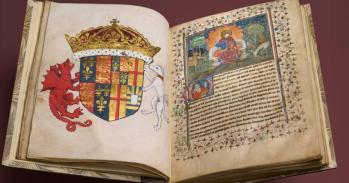
A mass grave found in Dorset could belong to a crew of Viking mercenaries who terrorised Europe in the 11th century – according to a new documentary on National Geographic which pieces together the story behind the burial.
A mass grave found in Dorset could belong to a crew of Viking mercenaries who terrorised Europe in the 11th century – according to a new documentary on National Geographic which pieces together the story behind the burial.
Clearly these men had shown a level of bravery similar to the Jomsviking code.
Britt Baillie
A crew of Viking mercenaries – some of the fiercest and most feared killers in the medieval world – could be the occupants of a mysterious mass grave in the south of England, according to a new theory.
The intriguing hypothesis is being put forward in a documentary, Viking Apocalypse, which will premiere on National Geographic UK on Wednesday, 25 January, and attempts to piece together the identities of a group of men who were apparently the victims of a horrific mass execution around the turn of the 11th century.
Their burial pit, at Ridgeway Hill, Dorset, was found in 2009 while archaeologists were working in the area ahead of the construction of a new road. In it, researchers made the gruesome discovery of the decapitated bodies of 54 young men. All had been dumped in the shallow grave, and their heads had been piled up on the far side.
Radiocarbon dating revealed that the remains belonged to men murdered at some point around the year 1000. This suggested a connection with the Vikings, because the Anglo-Saxons along the south coast at that time lived under constant threat of Viking raids. Isotope testing on the men’s teeth subsequently revealed that they had indeed come from Scandinavia. But exactly who they were has remained a mystery.
Now a University of Cambridge researcher is putting forward a compelling new theory about the identity of the murder victims. The documentary follows Dr Britt Baillie, from the McDonald Institute for Archaeological Research, as she examines the remains, as well as documents from the period and other material evidence, to reopen the file on what happened in Dorset a thousand years ago.
While historians will probably never agree conclusively about who the men were, Baillie’s analysis draws her to the conclusion that they may have been Viking mercenaries who modelled themselves on, or behaved in a similar way to the legendary Jomsvikings – a brotherhood of elite killers whose strict military code involved never showing fear, and never fleeing in the face of the enemy unless totally outnumbered.
Allegedly founded by Harald Bluetooth, the Jomsvikings are thought to have been based at a stronghold called Jomsborg on the Baltic coast. At a time when Vikings were feared across Europe, they were known as perhaps the fiercest of them all – a reputation which even earned them their own saga.
“The legends and stories of the Jomsvikings travelled around the medieval world and would almost certainly have been indicative of some of the practices of other bands of mercenaries or may even have been imitated by other groups,” Baillie said.
The documentary places the deaths in the context of the early 11th century and the troubled rule of Aethelred II – better known to history as Aethelred “the Unready”.
Although it is very unusual to find evidence of mass executions from the early medieval period, Aethelred’s reign is an exception. Following a series of Viking raids and threats to his own life, Aethelred decided, in 1002, to have all the Danish men living in England murdered on St Brice’s Day, 13 November – an event which became known as the St Brice’s Day massacre.
Historians differ about how many people were actually killed and whether those who were murdered were residents of the Danelaw (the Viking-occupied part of England at the time), or just mercenaries based elsewhere. Remains linked to the event have been found in Oxford, and it is likely that similar massacres took place in Bristol, Gloucester and London.
The bodies found in Dorset are quite possibly the victims of a similar act of butchery. Aethelred was known for playing divide and conquer with bands of Scandinavian mercenaries who worked for him, and it may be that these Vikings had fallen out of favour with the king. Certainly, the number of bodies corresponds to the number that would have been required to man a Viking longship of the period.
Yet the remains in Dorset also suggest that these men were something unique. Researchers have found that one of the men’s teeth had incisions. This rare feature could, it is believed, be the result of the victim filing his teeth deliberately to demonstrate his bravery and status.
Further analysis then reveals that the St. Brice’s day massacre victims in Oxford were killed in a frenzied mob attack. However, the Ridgeway Hill individuals were systematically executed. They were beheaded from the front - just like the warriors in the Jomsviking saga. In the saga, one captured Viking says: “I am content to die as are all our comrades. But I will not let myself be slaughtered like a sheep. I would rather face the blow. Strike straight at my face and watch carefully if I pale at all.”
Both traits link the execution victims to a group which, if not the Jomsvikings themselves, had similar principles and beliefs. But Baillie also finds further written evidence to support the idea. A source commissioned by Queen Emma, Aethelred’s second wife, hints that there was a group of Viking mercenaries somewhere in England at this time led by Thorkell the Tall, an alleged Jomsviking.
“Thorkell’s story is itself unclear and shrouded in legend,” Baillie added. “But Emma’s record connects Jomsvikings to England at exactly this time. Clearly these men had shown a level of bravery similar to the Jomsviking code. So while we cannot be certain about who they were, there are a number of tie-ins that take us down that route.”
This work is licensed under a Creative Commons Licence. If you use this content on your site please link back to this page.





